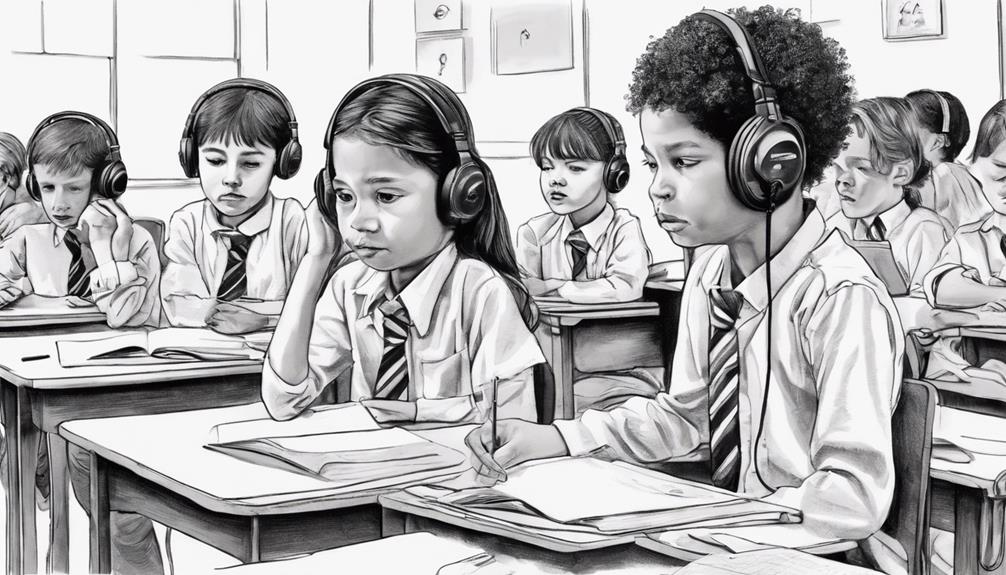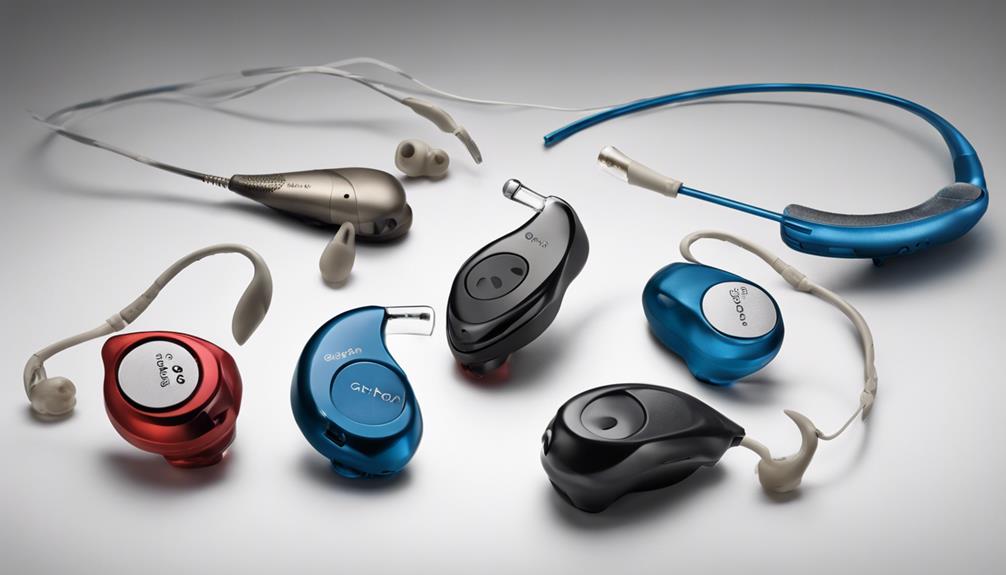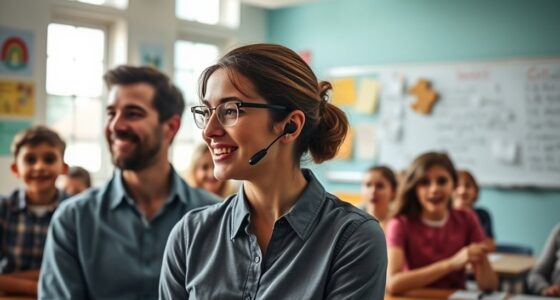When assessing tools to support children’s auditory needs, it is important to explore options that can enhance their educational experiences and social interactions with friends.
From devices that help with phone conversations to those that make watching TV more enjoyable, the advancements in assistive technology provide a range of solutions for children with hearing impairments.
However, there are five particular devices that stand out in terms of versatility and effectiveness. These devices not only cater to different needs but also promote inclusivity and accessibility in various settings where communication is key.
Key Takeaways
- FM systems clarify and amplify teachers' voices, aiding children's learning.
- Personal amplified systems enhance sound clarity for better understanding.
- Bluetooth systems offer seamless connectivity for enhanced auditory experiences.
- Infrared systems provide clear sound without interference, ideal for educational settings.
FM Systems for Children
When considering the use of FM systems for children, it becomes evident that these devices play a crucial role in enhancing communication and learning in classroom environments. FM systems are assistive listening devices that help clarify and amplify the teacher's voice specifically for children.
By doing so, these systems assist children with hearing aids in hearing their own voices better and improving their focus by allowing them to turn off their hearing aids, reducing distractions. This enhanced clarity benefits all students, not just those with hearing impairments, and can also be advantageous for ESL students.
However, it's important to note that FM systems require good classroom acoustics for optimal performance. In rooms with poor sound quality, these systems may face challenges in providing the necessary assistance.
Infrared Systems for Children

Infrared systems for children, utilizing advanced technology to transmit sound wirelessly via invisible light beams, offer a reliable solution for improving auditory accessibility in various settings. These systems are particularly beneficial for children with hearing loss in environments like classrooms where background noise can be a challenge.
Infrared systems excel in providing clear sound without interference, making them ideal for educational settings. They enhance the overall auditory experience for children by ensuring that sound is transmitted effectively, especially in group situations where traditional audio systems may struggle. Additionally, special devices for home TV listening are available with these systems, further catering to the auditory needs of children.
The technology behind infrared systems makes them a dependable choice for improving accessibility, especially in indoor locations like theaters or classrooms where maintaining clear sound quality is essential for children with hearing impairments.
Personal Amplified Systems for Children
Personal Amplified Systems for children enhance auditory experiences by amplifying sound and improving clarity in various listening environments, benefiting those with hearing loss. These systems are specifically designed to cater to a child's hearing needs and offer multiple advantages, such as:
- Portable Devices: Personal Amplified Systems for children are portable, allowing kids to carry them easily and use them wherever necessary, whether indoors or outdoors.
- Enhanced Communication Settings: These systems help children with hearing loss by amplifying sound, making it easier for them to engage in conversations in different communication settings.
- Educational Settings: Personal Amplified Systems are beneficial in educational settings as they improve the child's ability to hear and participate in classroom activities, ultimately enhancing their learning experience.
- Improved Clarity: By amplifying sound and enhancing clarity, these systems enable children with hearing impairments to better understand speech and other auditory cues.
Bluetooth Systems for Children

Bluetooth systems for children revolutionize auditory experiences by seamlessly transmitting sound via Wi-Fi, enhancing connectivity with Bluetooth-enabled hearing aids. These systems, a part of Hearing Assistive Technology, cater to children's specific hearing needs, providing clear and direct audio transmission. The versatility of Bluetooth systems allows for both indoor and outdoor use, optimizing the listening experience in various environments. Their compatibility with Bluetooth technology ensures seamless connectivity, offering convenience and ease of use for children utilizing hearing aids. Moreover, the direct audio transmission enhances the listening capabilities of children, making them a popular choice in the field of assistive listening devices. Below is a table summarizing key features of Bluetooth systems for children:
| Key Features | Benefits |
|---|---|
| Seamless Connectivity | Enhanced listening experience |
| Indoor and Outdoor Use | Versatile in various environments |
| Compatibility with Hearing Aids | Optimizes audio transmission for specific needs |
Audio Induction Systems for Children
As we shift our focus to Audio Induction Systems for children, it's important to highlight their innovative use of technology to transmit sound clearly and effectively in various settings. These systems utilize a microphone, amplifier, and wiring to eliminate background noise and ensure optimal sound transmission.
Here are some key points to consider:
- Audio Induction Systems are beneficial for large spaces like airports, banks, and auditoriums where clarity is essential for children's hearing.
- They wirelessly transmit sound to a receiver, making it easier for children with hearing devices to hear effectively in challenging environments.
- These systems are commonly used in settings where traditional sound amplification may not suffice, such as classrooms or public venues.
- By reducing distractions and enhancing the listening experience, Audio Induction Systems play a crucial role in assisting children who are hard of hearing, including those with cochlear implants.
The advanced technology of Audio Induction Systems significantly contributes to improving the auditory experience for children with hearing impairments.
Frequently Asked Questions
What Are Examples of Assistive Listening Devices?
We've several examples of assistive listening devices. They include:
- Audio induction systems, which use microphones and amplifiers for sound transmission in large spaces.
- FM systems, which utilize radio waves for wireless sound transmission in group meetings and classrooms.
- Infrared systems, which use light beams for sound transmission in indoor settings.
- Personal amplified systems, which are portable devices for one-on-one conversations or TV listening.
Which Type of Hearing Assistive Technology Is Best for Children?
When choosing the best hearing assistive technology for children, considering factors like the child's specific needs, the classroom environment, and the audiologist's recommendations is crucial. FM systems, amplifying the teacher's voice wirelessly, and sound-field systems, benefiting all students through speakers, are popular options.
Deciding on the most suitable system requires thorough testing and ongoing support for teachers. Integrating these technologies into a child's IEP ensures optimal learning outcomes in school.
What Is the Most Commonly Used Type of Assistive Listening System in Educational Settings?
In educational settings, the most commonly used type of assistive listening system is the FM system. It clarifies the teacher's voice, amplifying it above background noise for better communication. This system benefits all students, including those with normal hearing, by enhancing learning in noisy classrooms.
Additionally, sound-field systems, which amplify the teacher's voice through speakers, are also utilized. Both systems play a crucial role in improving educational experiences for students.
What Is Assistive Technology for Hearing Impaired in the Classroom?
Assistive technology for hearing impairments in the classroom includes systems like FM and sound-field systems to enhance auditory clarity and focus. These technologies benefit all students, not just those with hearing impairments, by improving communication and reducing distractions.
Audiologists play a key role in selecting and integrating these systems into a child's education plan. Different components like microphones and receivers can be utilized to create an optimal learning environment for all students.
Conclusion
In conclusion, these assistive listening devices for children are like a breath of fresh air in a world filled with noise.
From FM systems to Bluetooth devices, each technology provides a unique solution to enhance communication and accessibility for children with hearing impairments.
By utilizing these devices, children can navigate their everyday lives with ease and confidence, ensuring they never miss a beat.
So, why not give them the gift of clear, amplified sound and watch them flourish?











